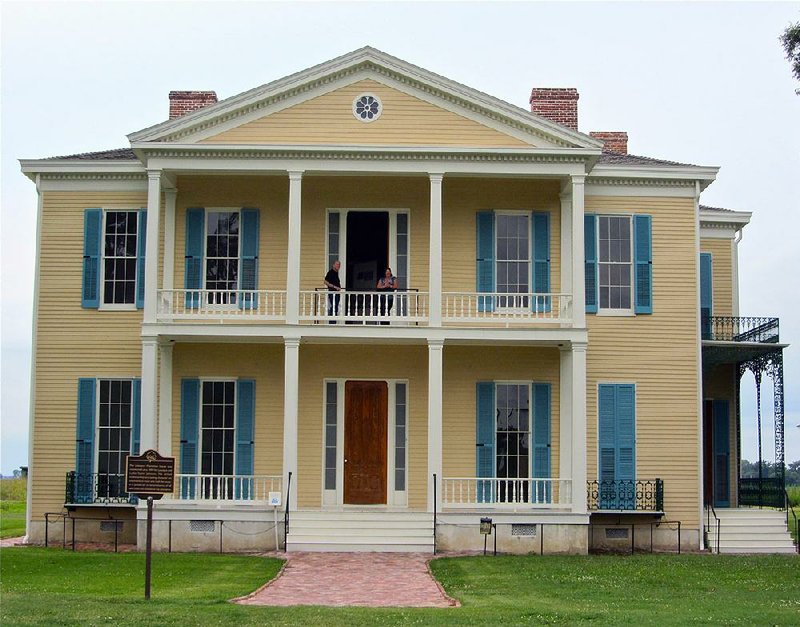LAKEPORT PLANTATION - It’s a survivor and the last of its kind, this antebellum belle rising like a relic of history on the flatland of Chicot County.
It hearkens back to the genteel days of Delta planters - and to the slave society that supported their comfortable way of life. It is Lakeport, the only example left from more than 50 plantations that stood before the Civil War along this meandering stretch of the Mississippi River in far southeast Arkansas.
After careful restoration that began in 2002, Lakeport Plantation has been open to the public since 2007 as an Arkansas State University Heritage Site, with a mix of new exhibits installed last year. Rather than being elaborately furnished in period style as are many historic homes, Lakeport emphasizes the human side of the place, explained by a mission statement:
“Rather than create another ‘pretty house,’ or one in which representative furnishings substitute for the original, this restoration and interpretation focuses on the lifestyles and relationships between the people who lived and worked at Lakeport - as slaves and masters, as tenant farmers and land owners.”
The 17-room house was built in 1859, largely with slave labor, by Lycurgus Johnson and his wife, Lydia. He was the son of Joel Johnson, who had come to Arkansas from Kentucky in 1831. Johnson descendants lived in the house until 1930. It was then occupied by tenants of subsequent Russian-immigrant owner Sam Epstein until 1972. Donated to ASU by the Epstein family in 2001, it still sits amid an active cotton farm.
Entering on the mandatory escorted tour, visitors immediately are shown one of the home’s most prized 19th-century artifacts. It’s a floor cloth, which a sign describes as one of “the most stylish treatments of the time” and “a rare gem in spite of much loss and wear, since few such cloths have survived. Two sections have been cleaned for display. One shows the pattern, created using 14 colors, each separately block printed.”
In the Music Room stands a gorgeous piano restored three years ago. A sign notes that it “first appeared on the Johnson’s tax records in 1869 (assessed at $500), along with a pleasure carriage ($50) and a watch ($200). The late addition suggests the house was not fully furnished before the Civil War, and the family was beginning to recover financially.”
As in the public-television hit Downton Abbey, devices existed to summon domestic help (slaves, in the case of Lakeport). A panel describes the bell system: “Three of Lakeport’s formal rooms - the south parlor, north parlor and music room - had servant bells. A fourth bell was located in the master bedroom. Levers in each room pulled wires connected underneath the house to mounted bells on the back porch near the kitchen.”
The importance of slaves at antebellum Lakeport is manifest in a display listing the names of 188 enslaved workers in 1858. With just a few exceptions, they are enumerated by first name only, from Abb, Aggy and Albert to West, Will and Zed. Two are called merely Patsy’s Child and Deborah’s Child. One is named Little George Washington.
Lakeport Plantation is a long drive - about 140 miles from Little Rock - and its regular opening times are limited (as noted below). But it can be combined with another worthwhile slice of history at Rohwer Japanese American Relocation Center in next-door Desha County. And it gets rave reviews on the widely used TripAdvisor site.
“We loved this antebellum home,” wrote a TripAdvisor contributor from Missouri last month. “Especially impressive is the authentic history and restoration. We spent two hours there and really enjoyed it. The house is surrounded by majestic trees. I had never seen cotton growing before. A must see!”
A visitor last fall from Pine Bluff was equally enthusiastic: “We happened upon this absolutely beautiful place while we were looking for a spot to pull over and eat a picnic lunch. We got out of the car to look around and a gentleman immediately came out and offered to take us inside for a tour. He was very informative and friendly. If you are looking for some education about pre-Civil War life, slavery and how plantations were run, this is the ticket!”
To reach Lakeport Plantation from Lake Village, take U.S. 82 south and east, curving along Lake Chicot almost to the bridge to Greenville, Miss. Near the Cow Pen restaurant, turn south on Arkansas 142 and go two miles to the plantation entrance on the left, a gravel drive between cotton fields. Ignore the “No Trespassing” sign, which is only for the farmland.
Lakeport Plantation is open for tours at 10 a.m. and 2 p.m. Monday-Friday. It may be possible to visit at other times by calling to make arrangements at (870) 265-6031. Admission is $5 ($3 for senior citizens, school-age children and groups of eight or more). Details can be found at lakeport.astate.edu.
Weekend, Pages 35 on 08/29/2013
